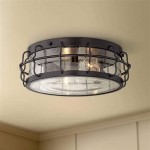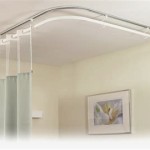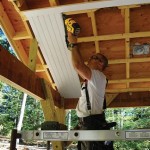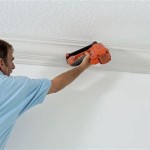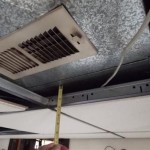Installing a Ceiling Fan on a Sloped Roof: A Comprehensive Guide
Installing a ceiling fan can significantly improve airflow and energy efficiency within a room. However, installing a ceiling fan on a sloped roof presents unique challenges compared to a standard flat ceiling installation. Proper preparation, understanding specific requirements, and adhering to safety guidelines are crucial for a successful installation.
This article outlines the necessary steps, considerations, and potential obstacles encountered when installing a ceiling fan on a sloped roof. By following this guide, individuals can safely and effectively install a ceiling fan, maximizing its functionality while ensuring the structural integrity of the ceiling and fan.
Key Considerations Before Installation
Before initiating the installation process, several key factors must be addressed to ensure compatibility and safety. These considerations involve assessing the slope of the ceiling, selecting the appropriate mounting hardware, and verifying the electrical capacity of the circuit.
Slope Assessment: The pitch of the sloped ceiling is a primary determinant in selecting the appropriate mounting solution. The steeper the slope, the greater the need for specialized hardware. Ceiling fans are typically rated for specific slope angles. Exceeding the recommended angle can compromise the fan's stability and potentially lead to failure. A standard ceiling fan mount is generally suitable for slight slopes, typically up to 14 degrees (a 3/12 pitch). Slopes beyond this require a specialized angled mount or a longer downrod, often coupled with a universal swivel adapter.
Measuring the ceiling slope accurately is critical. This can be achieved using a level, a protractor, and a measuring tape. Alternatively, a digital level with angle measurement capabilities provides a precise reading. Once the slope is determined, consult the ceiling fan's specifications and installation manual to confirm compatibility or determine the necessity for specialized mounting hardware.
Mounting Hardware Selection: The selection of appropriate mounting hardware is crucial for securely attaching the ceiling fan to the sloped ceiling. Several options are available, each designed for specific slope angles and load-bearing capabilities. These include angled mounting brackets, downrods of varying lengths, and universal swivel adapters.
Angled mounting brackets are designed to compensate for the slope, providing a level mounting surface for the fan. These brackets are typically adjustable, allowing for fine-tuning to achieve optimal balance. Downrods extend the fan from the ceiling, providing adequate clearance based on the ceiling height and slope. A longer downrod may be necessary to position the fan blades at the desired height. Universal swivel adapters connect the downrod to the mounting bracket, allowing the fan to rotate freely and maintain proper alignment on sloped surfaces.
When selecting mounting hardware, prioritize those certified by relevant safety standards organizations. This certification ensures that the hardware has undergone rigorous testing for load-bearing capacity and durability. Consult with a qualified electrician or structural engineer if uncertainty exists regarding the appropriate hardware for the specific slope and fan weight.
Electrical Capacity Verification: Before connecting the ceiling fan to the electrical circuit, it is imperative to verify that the circuit has sufficient capacity to handle the fan's electrical load. Overloading a circuit can lead to overheating, tripped breakers, and even fire hazards. Identify the circuit breaker that controls the ceiling fan's wiring. Check the amperage rating of the circuit breaker and compare it to the fan's power consumption, which is typically specified in the fan's documentation.
If the circuit already serves other appliances or lighting fixtures, calculate the total amperage draw to ensure it does not exceed the circuit breaker's rating. If the circuit is insufficient, consider installing a dedicated circuit for the ceiling fan. This task should be performed by a qualified electrician to ensure compliance with electrical codes and safety standards.
Step-by-Step Installation Process
The installation process involves several key steps, including preparing the work area, installing the mounting bracket, wiring the fan, and attaching the fan blades. Each step requires careful attention to detail and adherence to safety guidelines.
Preparing the Work Area: Before commencing the installation, prepare the work area by turning off the power to the circuit at the breaker box. Verify that the power is off using a non-contact voltage tester. Remove any existing light fixtures or ceiling fans from the installation location. Protect the floor with drop cloths or plastic sheeting to prevent damage from falling debris. Gather all necessary tools and materials, including a ladder, screwdrivers, wire strippers, wire connectors, a voltmeter, and the selected mounting hardware.
Installing the Mounting Bracket: Locate the ceiling joist above the desired installation location. Use a stud finder to identify the joist's edges. If an existing electrical box is present, ensure that it is rated for ceiling fan support. If not, replace it with a fan-rated electrical box that is securely attached to the joist. Position the mounting bracket over the electrical box and align the mounting holes with the joist. Secure the bracket to the joist using wood screws or lag bolts, ensuring a tight and stable connection. For angled mounting brackets, adjust the bracket to compensate for the ceiling slope, creating a level mounting surface.
Wiring the Fan: Refer to the ceiling fan's wiring diagram to identify the correct wire connections. Typically, the wiring involves connecting the black (hot) wire from the ceiling to the black wire from the fan, the white (neutral) wire from the ceiling to the white wire from the fan, and the green or bare copper (ground) wire from the ceiling to the corresponding ground wire on the fan. Use wire connectors to securely join the wires, ensuring a tight and insulated connection. Carefully tuck the wires into the electrical box, ensuring that they do not interfere with the fan's motor or moving parts.
Attaching the Fan Blades: Assemble the fan blades according to the manufacturer's instructions. Attach the blade brackets to the fan blades using screws, ensuring that they are securely fastened. Attach the fan blades to the fan motor housing using screws, ensuring that they are evenly spaced and properly aligned. Tighten all screws securely to prevent vibration and noise during operation.
Testing the Fan: After completing the installation, restore power to the circuit at the breaker box. Test the fan's operation by turning it on and off and cycling through the different speed settings. Check for any unusual noises or vibrations. If any issues are detected, turn off the power and re-examine the wiring connections and mounting hardware.
Addressing Common Challenges
During the installation process, several challenges may arise, requiring specific solutions. These challenges may include insufficient joist support, limited headroom, and difficulty in achieving proper balance.
Insufficient Joist Support: If the ceiling joist is not strong enough to support the weight of the ceiling fan, reinforcement may be necessary. This can be achieved by adding additional bracing or sistering additional joists to the existing one. Consult with a structural engineer to determine the appropriate reinforcement method for the specific situation. Securing a length of 2x6 or 2x8 lumber between two adjacent joists can provide a solid mounting base for the fan-rated electrical box.
Limited Headroom: On sloped ceilings, headroom can be limited, especially in rooms with low ceilings. To maximize headroom, use a flush mount or a shorter downrod. Flush mount fans are designed to sit close to the ceiling, minimizing the overall height. Alternatively, select a ceiling fan with a low-profile design. Ensure that there is adequate clearance between the fan blades and the ceiling to prevent airflow obstruction.
Achieving Proper Balance: Imbalance can occur due to uneven fan blades or improper installation. To address imbalance, use a balancing kit, which typically includes small weights that can be attached to the fan blades. Experiment with different weight placements until the vibration is minimized or eliminated. Ensure that all screws are tightened securely and that the fan blades are properly aligned. A slight bend in a blade can also cause imbalance; gently adjust the blade to correct any such deviations.
Installing a ceiling fan on a sloped roof requires careful planning, attention to detail, and adherence to safety guidelines. By addressing key considerations, following the step-by-step installation process, and addressing potential challenges, individuals can successfully install a ceiling fan, enhancing comfort and energy efficiency.

How To Install A Ceiling Fan On Sloped Lemon Thistle

Mounting Ceiling Fan On Sloped Home Improvement Stack Exchange

How To Install A Ceiling Fan On Sloped Lemon Thistle

How To Choose A Ceiling Fan For Vaulted Ceilings Lightology

Electrical Mount Ceiling Fan At The Peak Of A Sloped Home Improvement Stack Exchange

Install Ceiling Fan On Sloped Simple Modern Handmade Home

Can Ceiling Fans Be Installed On Vaulted Or Sloped Ceilings

How To Choose A Ceiling Fan For Vaulted Ceilings Lightology

How To Install A Ceiling Fan On Sloped Lemon Thistle

How To Install A Ceiling Fan Hunter
Related Posts


